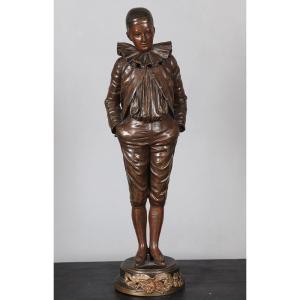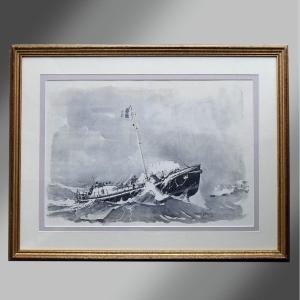Signed: Signed in pencil by Gen Paul in the white margin on the right, artist referenced and side, proof: HC (Hors Commerce)
Subject: Edith PIAH the French Cancan, Montmarte Paris
Dimensions: Height: 54 cm, Width: 67 cm, on Vélin d'Arches paper
Sold without frame
Biography:
Eugène PAUL known as Gen PAUL 1895 / 1975
Gen Paul, born July 2, 1895 in Paris 18eme, and died April 30, 1975 in Paris, is a French expressionist painter. He was also a gouachist, draftsman, engraver, and lithographer. A friend of Louis-Ferdinand Céline, Gen Paul was self-taught, sometimes reductively referred to as the "painter of Montmartre." He was introduced to engraving by Eugène Delâtre.
The First World War broke out. He was sent as a soldier and wounded twice, once seriously, losing a leg.
During his convalescence, he began painting again and became friends, at the Bateau-Lavoir, with Juan Gris, who helped him a lot. Although Gen Paul did not attend a school of Fine Arts during his training, he proved talented enough to make a living from his art for almost 60 years. His early works seem to reflect many crossed influences, including those of his friends from Montmartre: Vlaminck, Utrillo, Frank Will, Leprin and Lucien Génin, but he quickly developed a personality tinged with an expressionism that reflected influences as varied as those of Toulouse-Lautrec, van Gogh, Cézanne, and before them Goya, Velázquez, El Greco, influences that can be found at this time in the work of his friend Henri-Martin Lamotte.
The Cubist influences of Gris, Braque, Picasso and Fernand Léger are felt in some of his works, while many of his urban landscape engravings are much more "realistic". During the interwar period, from 1925 to 1929, as the painter sought to overcome his physical handicap and the memory of the horrors of war, he produced several of his paintings considered to be his best. His first oil painting, a Moulin de la Galette seen from his window, dates from 1916.
His beginnings were uncertain; he mainly made views of Paris in the style of the great painters to satisfy commissions. Gen Paul was exhibited for the first time at the Salon d'Automne and the Salon des Indépendants in Paris in 1920, a time when Henri-Martin Lamotte was among his friends and he rubbed shoulders with Camille Pissaro and the "Partists" group. In 1928, his works were exhibited with those of Picasso and Soutine, which shocked some of the public.
From the 1930s onwards, Gen Paul sank into alcoholism, which complicated chronic health problems. In 1934, he was officially recognized for his contributions to French art and awarded the Legion of Honor. In 1937, in addition to numerous scenes of his Montmartre neighborhood and portraits of his friend, the composer Darius Milhaud, Gen Paul is known to have painted and drawn in the United States, scenes of jazz and classical musicians, subjects in which he showed great interest. Many of his works are held in private collections, but a significant number are in museums in France and other European countries, such as the museums of Bern and Granville.
The Museum of Modern Art of the City of Paris holds two large paintings from the late 1930s in its reserves. Gen Paul died at the Pitié-Salpêtrière Hospital in Paris on April 30, 1975. He is buried in the Saint Vincent Cemetery in Montmartre.
Sold with Invoice
visible at our gallery in L'Isle sur la Sorgue (France), on weekends.
Free shipping in a tube for France and on estimate for abroad.































 Le Magazine de PROANTIC
Le Magazine de PROANTIC TRÉSORS Magazine
TRÉSORS Magazine Rivista Artiquariato
Rivista Artiquariato